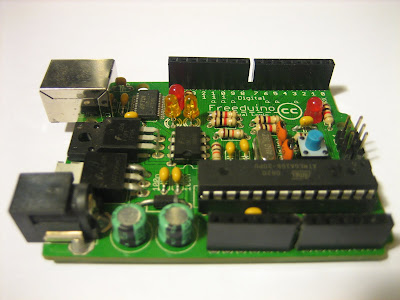Arduino uses an Ethernet board based on
Wiznet W5100, however there are some alternatives a bit cheaper with their own libraries, in this case I’ve chosen an Ethernet adapter from seeed-studio (from China). The
seeed-studio Ethernet adapter is based in a project from
nuelectronics.com using an ENC28J60 Ethernet chip. The ENC28J60 will be responsible to manage the TCP connection, to do this, a number of packets needs to be exchanged between two sides first to establish the connection; then data packets can be exchanged. Usually a complicated state-machine is needed to implement the TCP protocol. For Auduino’s ATMEGA168, an 8-bit microcontroller with 1KB, it is impossible to implement the full TCP stack. Therefore, instead of implementing full TCP protocol, a single data packet TCP protocol is used. The webpage contents, including all html tags, must be in one packet. The length of packet is limited to 500 bytes.

Seee-studio ethernet adapter mounted on top of freeduino, 1-wire bus is connected to digital pin 7







